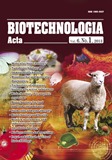ISSN 2410-7751 (Print)
ISSN 2410-776X (Online)

"Biotechnologia Acta" v. 6, no. 1, 2013
Р. 125-137, Bibliography 22, English.
Universal Decimal classification: 663.125:663.222.061:663.252.4
MAGNETIC FIELD EFFECT ON YEAST Saccharomyces cerevisiae ACTIVITY AT GRAPE MUST FERMENTATION
Odesa Mechnikov National University, Ukraine
Treatment of yeast cultures using magnetic fields enables us to gain a better understanding of the magnetic fields’ action on enzyme activity and the fluctuation of macro- and micro-element concentrations within yeast cultures. For this purpose, the two following groups of yeast were studied: laboratory yeast cultures isolated from regional grape must and commercial yeast cultures that are commonly used in the wine industry. Both yeast groups were biochemically tested with and without magnetic field treatment exposure. We used the following parameters of magnetic field frequency: 160 Hz with an intensity of 5 mT and an exposure time of 30 minutes. Based on our laboratory tests, the yeast cultures that were not exposed to magnetic field treatment had a high correlation between the activities of alcohol dehydrogenase and cocarboxylase. The groups of yeast that underwent magnetic field treatment had a high correlation between the activities of alcohol dehydrogenase, alanine aminotransferase, amylase and phosphatase.
Study of the morphology of Saccharomyces cerevisiae yeast followed by magnetic field treatment illustrated that between 30 and 70% of the magnetic field treated yeast died. The surviving yeast cultures in the grape must (confirmed by Gram staining) revealed increased enzymatic activity and a high correlation between levels of potassium and calcium, as well as between levels of potassium and magnesium.
Key words: Saccharomyces cerevisiae, enzyme activity, macro- and micro-elements, wine biotechnology.
References © Palladin Institute of Biochemistry of National Academy of Sciences of Ukraine, 2008
References
1. Anton-Leberre V., Haanappel E., Marsaud N. Exposure to high static or pulsed magnetic fields does not affect cellular processes in the yeast Saccharomyces cerevisiaeю. Bioelect romagnetics. 2010, 31(1), 28–38.
2. Bayraktar V. N. Symbiotic interaction for yeast Saccharomyces cerevisiae and Lactobacteries isolated after spontaneous fermentation of grape must. The Grape J. 2010, 28(5), 69–73.
3. Bayraktar V. N. Biochemical study of carbohydrates fermentation while using yeast cultures of Saccharomyces cerevisiae isolated during spontaneous fermentation from musts of grape Tairov`s selection. The Grape J. 2011, 38(4), 42–51.
4. Gao Mengxiang, Ma Haile, Guo Kangquan. Sterilization of Watermelon Juice Using Pulsed Magnetic Field. Food Ferment. Ind. 2004, N 3, P. 14–17.
5. Harte F., San Martin M. F., Lacerda, A. H. Potential use of 18 Tesla static and pulsed magnetic fields on Escherichia coli and Saccharomyces cerevisiae. J. Food Proc. Preserve. 2001, 25(3), 223–235.
https://doi.org/10.1111/j.1745-4549.2001.tb00456.x
6. Hofman G. A. Deactivation of microorganisms by an oscillating magnetic field. Patent US 4524079, 1985.
7. Iftime O., Ghindea R., Vassu T. Identificationof yeasts in late stages of spontaneous fermentation of a red grape must. University of Bucharest. Romania. 2007, P. 1–3. Avaiable at http://www.rombio.eu/vol12nr6/8.htm
8. Santosa L. O., Alegreb R. M., Garcia-Diegoc C., Cuellarc J. Effects of magnetic fields on biomass and glutathione production by the yeast Saccharomyces cerevisiae. J. Proc. Biochem, 2010, 45(8), 1362–1367.
https://doi.org/10.1016/j.procbio.2010.05.008
9. Malko J. A., Constantinidis, I., Dillehay, D., Fajman W. A. Search for influence of 1.5 Tesla magnetic field on growth of yeast cells. Bioelectromagnetics. 1994, V. 15, P. 495–501.
https://doi.org/10.1111/j.1745-4549.2001.tb00456.x
10. Markkanen A., Juutilainen J., Lang S. Effects of 50 Hz magnetic field on cell cycle kinetics and the colony forming ability of budding yeast exposed to ultraviolet radiation. Bioelectromagnetics. 2001, 22(5), 345–350.
https://doi.org/10.1002/bem.60
11. Moore R. L. Biological effects of magnetic fields. Studies with microorganisms. Can. J. Mic robiol. 1979, V. 25, P. 1145–1151.
https://doi.org/10.1139/m79-178
12. Fakhrullin R. F., Garcнa-Alonso J., Paunov V. N. A direct technique for preparation of magnetically functionalized living yeast cells. Soft Matter. 2010, N 6, P. 391–397.
https://doi.org/10.1039/B914065D
13. Ruiz-Gomez M. J., Sendra-Portero F., Martinez-Morillo M. Effect of 2.45 mT sinusoidal 50 Hz magnetic field on Saccharomyces cerevisiae strains deficient in DNA strand breaks repair. Int. J. Radiat. Biol. 2010, 86(7), 602–611.
https://doi.org/10.3109/09553001003734519
14. Ruiz-Gomez M. J., Ristori-Bogajo E., PrietoBarcia M. I., Martinez-Morillo M. No evidence of cellular alterations by Milli Teslalevel static and 50 Hz magnetic fields on S. cerevisiae. Electromagn. Biol. Med. 2010, 29(4), 154–164.
https://doi.org/10.3109/07435800.2010.505158
15. Satora P., Tuszynski T. Biodiversity of Yeasts During Plum Fermentation. Food Technol. Biotechnol. 2005, 43(3), 277–282. Avaiable at http://www.ftb.com.hr/43/43-277.pdf
16. Egami S., Naruse Y., Watarai1 H. Effect of static magnetic fields on the budding of yeast Cells. Bioelectromagnetics. 2010, 31(8), 622–629.
https://doi.org/10.1002/bem.20599
17. Trukhan E. M. Impact of weak electro-magnetic fields on biological activity of water phase. Mod. Comp Res. J. 2009, l(1), 101–108.
18. Van Nostran F. E., Reynolds R. J., Hedrick H. G. Effects of a high magnetic field at different
osmotic pressures and temperatures on multiplication of Saccharomyces cerevisiae. Appl.Microbiol. 1967, V. 15, 561–563.
19. Voychuk S. I., Gromozova E. N., Lytvyn P. M., Podgorsky V. S. Changes of Surface Properties of Yeast Cell Wall Under Exposure of Electromagnetic Field (40.68 MHz) and Action of Nystatin. The Environmentalist. 2005, V. 25, Iss. 2, N 4, P. 139–144.
20. Yang X., Beckwith A. W., Miller J. H., Wood L. T. Observation of magnetic fieldinduced contraction of fission yeast cellsusing optical projection microscopy. Cent.Europ. J. Phys. 2004, 2(4), 636–644.
21. Yoshimura N. Application of magnetic action for sterilization of food. Shokukin Kihatsu. 1989, 24(3), 46–48.
22. Qiaorong Y., Mengxiang G., Haile M. Steri li zation Effect of Pulsed Magnetic Field and Its’ Influence on Food Quality. J. Microwaves. 2004, 20(3), 82–85.

